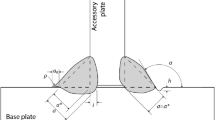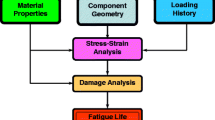Abstract
The starting point of the investigations presented in this paper is the simplified consideration of mean and residual stresses as well as the complete disregard of the complex failure mechanisms in the common fatigue standards and guidelines. An improved fatigue life assessment for welded components, which includes the crack initiation and propagation phase is the scope of this paper. The crack initiation phase is considered using the strain–life approach. The crack propagation life, starting from a technical crack of a depth of a = 0.5 mm, is derived by the application of linear–elastic fracture mechanics. In this two–phase approach, the mean and residual stresses are considered by using damage parameters for the initiation phase and effective stress intensity factors for the propagation phase. With this approach, a better understanding can be obtained of the influence of mean– and residual stresses and their influence on the course (slope k and knee point N k ) of the S–N curve. With this information to hand, a more reliable fatigue assessment can be achieved than is possible with the common standards and guidelines. With the proposed two-phase approach, higher permissible stresses can be allowed in the design phase, leading to resource-efficient, lightweight constructions.













Similar content being viewed by others
References
Hobbacher A (ed) (2009) Recommendations for fatigue design of welded joints and components. Welding Research Council, Bulletin 520
Radaj D (1996) Int J Fatigue 18(3):153–170
Zerbst U, Madia M, Eufinger J, Bruder T (2012) DVM Bericht 139: Werkstoffe und Fügeverfahren - Neue Herausforderungen für die Betriebsfestigkeit
Maddox S (1971) Procs. conf. fatigue of welded structures
Maddox S (1975) Int J Fract 11(3):389
Mohaupt U, Burns D, Kalbfleisch J, Vosikovsky O, Bell R (1987) Steel in marine structures. In: Proceedings of the 3rd international ECSC offshore conference on steel in marine structures (SIMS ’87), Delft, the Netherlands, 15–18 June . Elsevier, Amsterdam
Verreman Y, Nie B (1991) Fatigue fract Eng Mater Struct 14(2–3):337
Olivier R, Koettgen VB (1991) Schweißverbindungen II - Untersuchung zur Einbindung eines neuartigen Zeit- und Dauerschwingfestigkeitsnachweises von Schweißverbindungen aus Stahl in Regelwerke. Vorhaben Nr. 128, Heft Nr. 180. Forschungkuratorium Maschinenbau (FKM)
Hobbacher A (2008) International institute of welding JWG-XIII-XV-197-08
Lassen T, Recho N (2009) Int J Fatigue 31:70
Darcis P, Lassen T, Recho N (2006) Weld J 85(1):19
Chen N, Lawrence F (1998) Advances in Fatigue Crack Closure Measurement and Analysis: Second Volume. In: McClung R (ed). American Society for Testing and Materials ASTM, pp 351–367
Dimitrakis S, Lawrence F (1999) FCP report no. 184, improving the fatigue life of weldments with longitudinal attachments. Tech. rep., College of Engineering, University of Illinois
Chattopadhyay A, Glinka G, El-Zein M, Qian J, Formas R (2011) Weld World 55:2
Hou CY, Charng JJ (1997) Int J Fatigue 19(7):537
Hou C, Chen N, Lawrence FV (1994) FCP report no. 166, computer simulation of weldment fatigue life. Tech. rep., Collage of Engineering, University of Illinois
Lawrence F, Ho NJ, Mazumdar P (1981) Annu Rev Mater Sci 11:401
Lihavainen VM (2006) A novel approach for assessing the fatigue strength of ultrasonic impact treated welded structures. Ph.D. thesis, Lappeenranta University of Technology
Remes H (2008) Strain-based approach to fatigue strength assessment of welded joints. Ph.D. thesis, Helsiki University of Technology
Schaumann P, Keindorf C (2010) Stahlbau 79:34
Verreman Y, Nie B (1996) Fatigue Fract Eng Mater Struct 19(6):669
Peterson R (1959) Metal fatigue. McGraw-Hill, New York. Critical distance
Neuber H (1937) Kerbspannungslehre, Grundlagen für genaue Spannungsberechnung. Verlag von Julius Springer, Berlin
Seeger T (1996) Stahlbau Handbuch 1 Teil B. Stahlbau-Verlagsgesellschaft mbH Köln
Boukharouba T, Tamine T, Niu L, Chehimi C, Pluvinage G (1995) Eng Fract Mech 52(3):503
Lazzarin P, Livieri P (2001) Int J Fatigue 23:225
Lazzarin P, Berto F, Gomez F, Zappalorto M (2008) Int J Fatigue 30:1345
Schütz W (1967) Zeitschrift für Flugwissenschaft 15:407
Smith K, Watson P, Topper T (1970) J Mater 5:767
Harter J, AFGROW Users Guide And Technical Manual AFRL-VA-WP-TR-2008-XXXX. Air Force Research Lab WPAFB OH (2008)
Haibach E, Seeger T (1998) Materialwiss Werkstofftech 29:199
Sonsino CM, Bruder T, Baumgartner J (2010) Weld World 54:375
Bruder T, Störzel K, Baumgartner J, Hanselka H (2012) Int J Fatigue 34(1):86
Gurney T (1977) Residual stresses in welded constructions and their effects. In: International Conference, 15–17 November, London. The Welding Institute, Abington Hall, pp 151– 163
Ohta A, Maeda Y, Mawari T, Nishijima S, Nakamura H (1986) Int J Fatigue 8(3):147
Taylor D (1999) Int J Fatigue 21:413
Neuber H (1968) Konstruktion 20(7):245
Kuguel R (1961) 64th Annual Meeting of the Society (ASTM), pp 732–744
Sonsino CM (1995) Int J Fatigue 17(1):55
Topper T, Wetzel R, Morrow J (1967) Report no. NAEC-ASL-1114: Neuber’s rule applied to fatigue of notched specimens. Tech. rep., Aeronautical Structures Laboratory
Albrecht P, Yamada K (1977) J Struct Div 103(2):377
Glinka G, Shen G (1991) Eng Fract Mech 40(6):1135
Sonsino CM (2009) Int J Fatigue 31:88
Sonsino CM, Kaufmann H, Wagener R, Fischer C, Eufinger J (2011) Weld World 55(11–12):66
Baumgartner J, Bruder T (2013) Weld World 57:841
Varfolomeev I, Moroz S, Brand M, Siegele D, Baumgartner J IWM Bericht w 17/2011: Lebensdauerbewertung von Schweißverbindungen unter besonderer Berücksichtigung von eigenspannungen
Baumgartner J (2013) Schwingfestigkeit von Schweißverbindungen unter Berücksichtigung von Schweißeigenspannungen und Größeneinflüssen. Ph.D. thesis, Technische Universität Darmstadt
Vormwald M (2011) Materials Testing 53:98
Maddox S (1976) Welding research international 6(5)
Radaj D (1985) Gestaltung und Berechnung von Schweißkonstruktionen, Ermüdungsfestigkeit. Verlag für Schweißtechnik, DVS
Hensel J, Nitschke-Pagel T, Schönborn S, Dilger K (2012) International institute of welding XIII-2441-12
Acknowledgments
Parts of the investigations presented here were supported by financial funding from Federal Ministry of Economics and Technology BMWi over the AiF e.V. (Arbeitsgemeinschaft industrieller Forschungsvereinigungen ”Otto von Guericke” e.V.) under the grant 15.913N. Technical and scientific support during the project was given by the German Welding Society DVS (Forschungsvereinigung Schweißen und verwandte Verfahren e. V.) in the working group FA9 (Design and Assessment). The author would like to thank the AiF, the DVS, and the members of the FA9 for their support.
Author information
Authors and Affiliations
Corresponding author
Additional information
Recommended for publication by Commission XIII - Fatigue of Welded Components and Structures
Rights and permissions
About this article
Cite this article
Baumgartner, J. Enhancement of the fatigue strength assessment of welded components by consideration of mean and residual stresses in the crack initiation and propagation phases. Weld World 60, 547–558 (2016). https://doi.org/10.1007/s40194-016-0304-1
Received:
Accepted:
Published:
Issue Date:
DOI: https://doi.org/10.1007/s40194-016-0304-1




